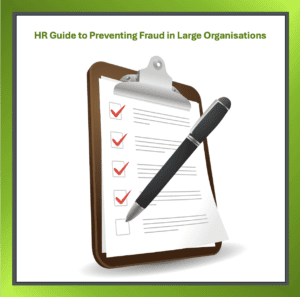HR Guide to Preventing Fraud in Large Organisations
A new UK law is changing how organisations guard against fraud. If you’re a large organisation, you could face unlimited fines if you don’t have reasonable anti-fraud procedures in place and a fraud benefits the organisation or its clients.
This guide outlines what HR needs to do, risk assessment, a tailored prevention plan, and ongoing monitoring, to stay compliant and protect the business.
Failure to prevent fraud became law in the UK on 1 September 2025. If a “large organisation” fails to have reasonable procedures and a fraud benefits the organisation or its clients, the organisation can face unlimited fines and reputational damage.
HR must work with compliance and senior leadership to assess risk, create a fraud prevention plan, and regularly monitor and update controls.
Who’s affected: “Large organisations” meeting at least two of these: over 250 employees, turnover over £36m, or assets over £18m. The rule can still touch organisations with overseas activity or those acting as agents for large organisations.
What counts as fraud: Any dishonest action that benefits the organisation or its clients, even if the organisation didn’t know about it. Benefits can be non-financial, and intent matters.
Why compliance matters: If the organisation can show it had reasonable procedures, it can defend against liability. There’s no one-size-fits-all approach; measures must fit the specific risks
How to be compliant (three steps):
1.Risk assessment: Identify opportunities, motives, and cultural factors that could enable fraud. Make the assessment specific and well-documented.
2.Fraud prevention plan: Implement risk-based, proportionate controls. Include training, clear reporting channels, a stated commitment to anti-fraud efforts, and due diligence on staff, contractors, and partners.
3.Monitor and review: Regularly reassess risks and update the plan. Document procedures and incidents; review annually or more often for high-risk areas.
HR focus: Leadership alignment, targeted training for high-risk roles, awareness of whistleblowing procedures, and ongoing engagement with compliance.

